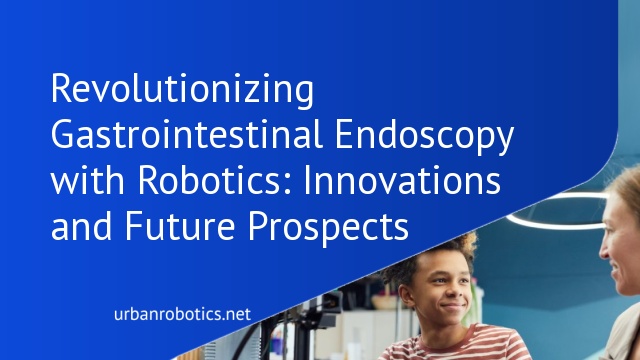What Is Gastrointestinal Endoscopy with Robotics?
Gastrointestinal endoscopy with robotics employs advanced robotic systems to navigate the digestive tract. This technology enhances precision and control during the endoscopic procedure. Traditional endoscopy uses flexible tubes with cameras, whereas robotic-assisted devices offer more dexterity and stability.
Robotic endoscopy systems feature articulated arms and high-definition visuals, allowing for detailed examinations and interventions. Surgeons can perform intricate tasks without extensive incisions, significantly reducing recovery times.
One notable example is the use of robotic platforms like the Flex Robotic System, which provides flexibility and maneuverability. This system improves access to hard-to-reach areas within the gastrointestinal tract, increasing diagnostic accuracy.
The integration of robotics in endoscopy also allows for real-time data and imaging. This capability aids in immediate decision-making during procedures. As a result, patient outcomes and overall satisfaction improve markedly.
Advantages of Robotic Endoscopy
Robotic endoscopy offers significant benefits in gastrointestinal procedures. These advantages enhance patient care and improve procedural outcomes.
Precision and Accuracy
Robotic endoscopy enhances precision and accuracy. The technology provides superior control and dexterity, allowing for exact movements within the gastrointestinal tract. Complex procedures become more straightforward due to the advanced imaging and navigation capabilities. This precision reduces the risk of complications and improves diagnostic accuracy.
Minimally Invasive Procedures
Robotic endoscopy enables minimally invasive procedures. This approach allows for smaller incisions, reducing patient discomfort and recovery times. Less invasive techniques are especially beneficial for accessing hard-to-reach areas. With faster recovery and fewer complications, patients experience improved overall outcomes.
Current Technologies in Robotic Endoscopy
Robotic endoscopy has revolutionized gastrointestinal procedures by offering advanced precision and improved patient outcomes. Various technologies and manufacturers play critical roles in this innovation.
Types of Robotic Endoscopic Systems
Several robotic endoscopic systems enhance gastrointestinal procedures. The Flex Robotic System is renowned for its ability to navigate complex anatomy. The EndoMaster offers robotic assistance for intricate surgical tasks. The STRAS system combines robotic control with advanced visualization. These systems enable minimally invasive procedures, reduce recovery times, and increase diagnostic accuracy.
Key Manufacturers and Innovations
Leading manufacturers drive innovations in robotic endoscopy. Medrobotics developed the Flex Robotic System, providing flexible access. EndoMaster Pte Ltd focuses on automated surgical technologies. Intuitive Surgical, known for the da Vinci system, advances minimally invasive techniques. These companies continually enhance their systems, offering better precision, control, and patient outcomes.
Applications of Robotic Endoscopy
Robotic endoscopy offers transformative applications in gastrointestinal procedures, enhancing diagnostic and therapeutic capabilities.
Diagnosing Gastrointestinal Disorders
Robotic endoscopy improves the precision of diagnosing gastrointestinal disorders, enabling more accurate identification of abnormalities. For instance, tools like the EndoMaster system enhance real-time imaging, making it easier to detect polyps, ulcers, and tumors. Increased maneuverability allows thorough examination of hard-to-reach areas within the digestive tract, leading to earlier and more accurate diagnoses compared to traditional methods. Studies show a higher detection rate of gastrointestinal lesions with robotic assistance.
Therapeutic Interventions
Robotic endoscopy facilitates advanced therapeutic interventions by enabling minimally invasive techniques. One example is the precise excision of tumors, such as those in the colon or stomach, which minimizes tissue damage and speeds recovery. Additionally, systems like the Flex Robotic System aid in performing complex procedures like suturing or stent placement with greater precision. Researchers have noted reduced complication rates and improved patient outcomes in therapeutic endoscopic procedures using robotic systems.
Limitations and Challenges
Despite advancements, gastrointestinal endoscopy with robotics faces several limitations and challenges. Addressing these issues is crucial for broader adoption and improved patient outcomes.
Technical Limitations
Robotic endoscopes rely on complex systems that can be prone to technical glitches. Calibration errors, software bugs, and hardware malfunctions are not uncommon. Limited tactile feedback and delayed response times can hinder the precision that manual techniques offer. Training requirements for operating robotic systems are extensive. Only highly skilled professionals can effectively handle these devices, limiting their widespread use in medical facilities.
Costs and Accessibility
Robotic systems are expensive, with initial costs ranging from $500,000 to over $2 million. Ongoing maintenance and training add to financial burdens. Smaller hospitals and clinics struggle to afford such technology. Accessibility issues also arise in rural or underserved areas where resources are limited. Healthcare disparities grow if robotic endoscopy technologies are not accessible to all patients. Efforts to reduce costs and improve accessibility are essential for equitable healthcare advancements.
Future Prospects
Gastrointestinal endoscopy with robotics continues evolving, promising numerous advancements in technology and clinical practice.
Emerging Technologies
Ongoing research focuses on novel robotic systems featuring enhanced AI and machine learning capabilities. These technologies are expected to increase the automation of diagnostic and therapeutic procedures, reducing operator dependency. Companies like Medtronic and Olympus are exploring edge AI and real-time analytics for swift, precise interventions. Capsule endoscopy and magnetic control advancements may further enable non-invasive procedures, offering greater patient comfort and accessibility.
Potential Improvements
Future robotic systems aim to integrate superior haptic feedback and faster response times to overcome existing limitations. Cost reductions through innovative manufacturing methods could make these advanced technologies more accessible to smaller healthcare facilities. Partnerships between technology developers and healthcare providers may accelerate standardized training programs, broadening the scope of skilled professionals. By addressing current challenges, we can bring about optimized, cost-effective solutions for enhanced patient care across diverse settings.
Conclusion
Gastrointestinal endoscopy with robotics represents a significant leap forward in medical technology. The precision and control offered by systems like the Flex Robotic System and EndoMaster are revolutionizing patient care. Although challenges such as technical issues and high costs remain, the future looks promising with ongoing advancements in AI and machine learning.
Companies like Medtronic and Olympus are at the forefront of developing more automated and patient-friendly technologies. Improved haptic feedback and faster response times are on the horizon, aiming to make these advanced systems more accessible and effective. Partnerships between tech developers and healthcare providers are essential for overcoming current limitations and enhancing training programs.
As we continue to innovate and collaborate, the potential for optimized, cost-effective solutions in gastrointestinal endoscopy grows, promising better outcomes for patients worldwide.





